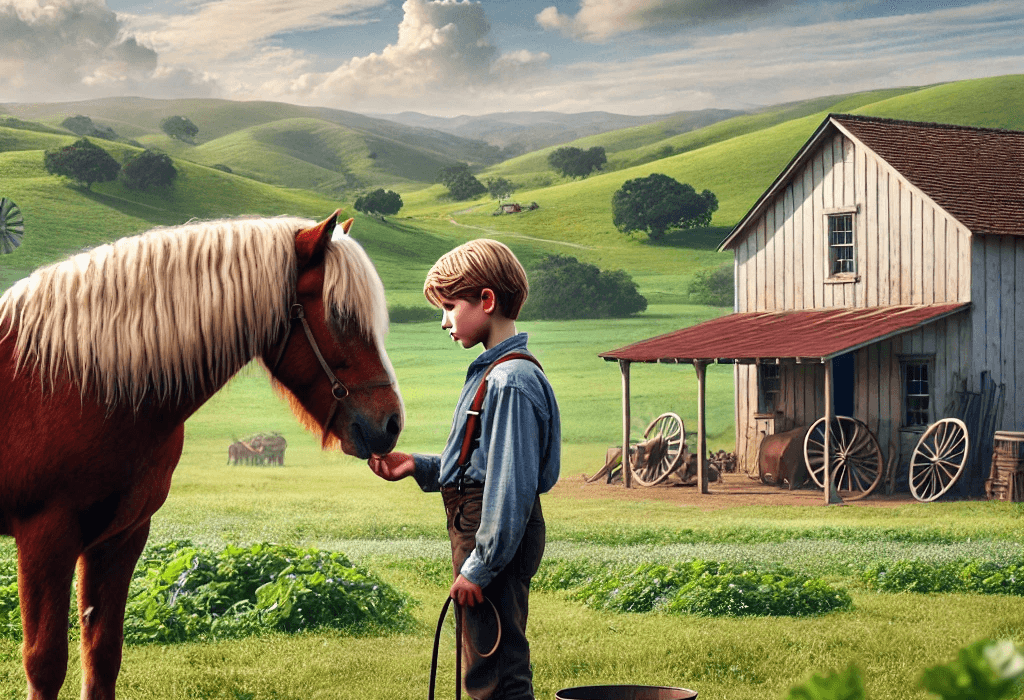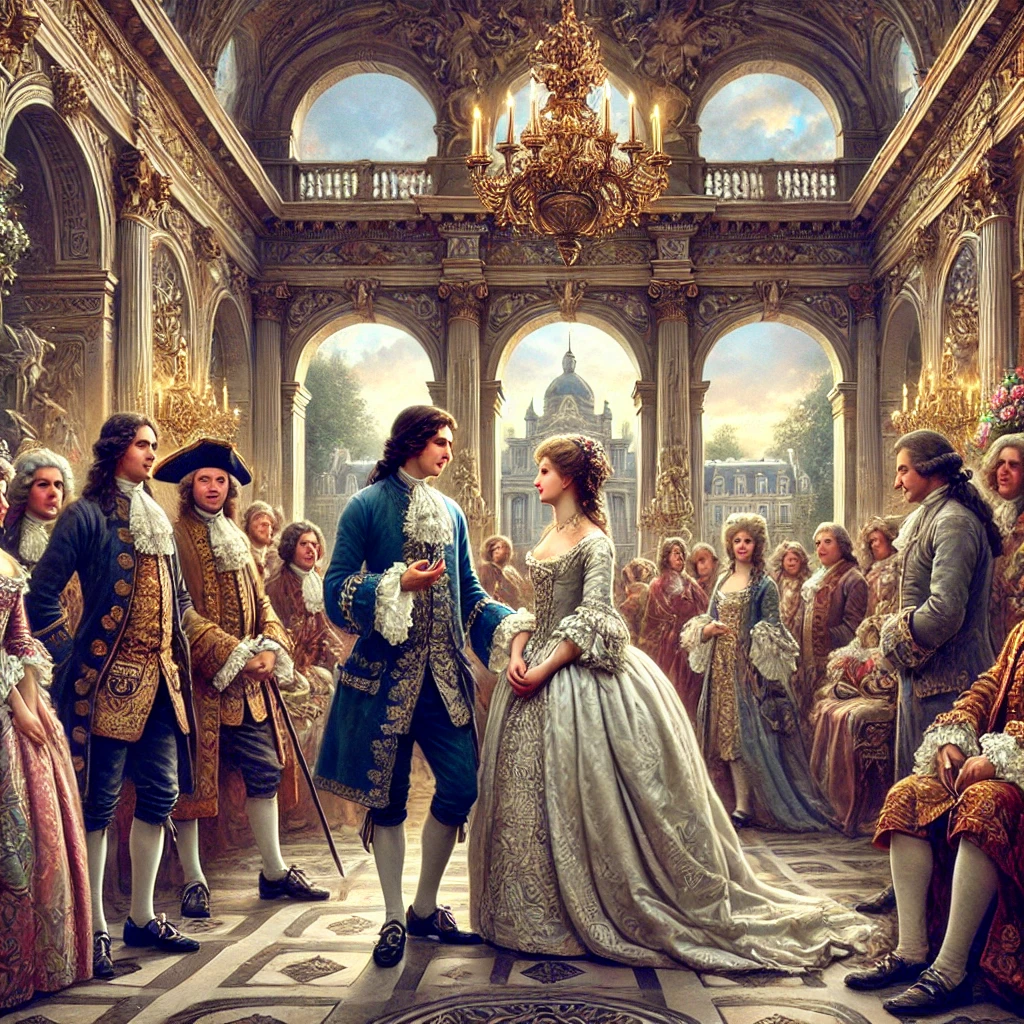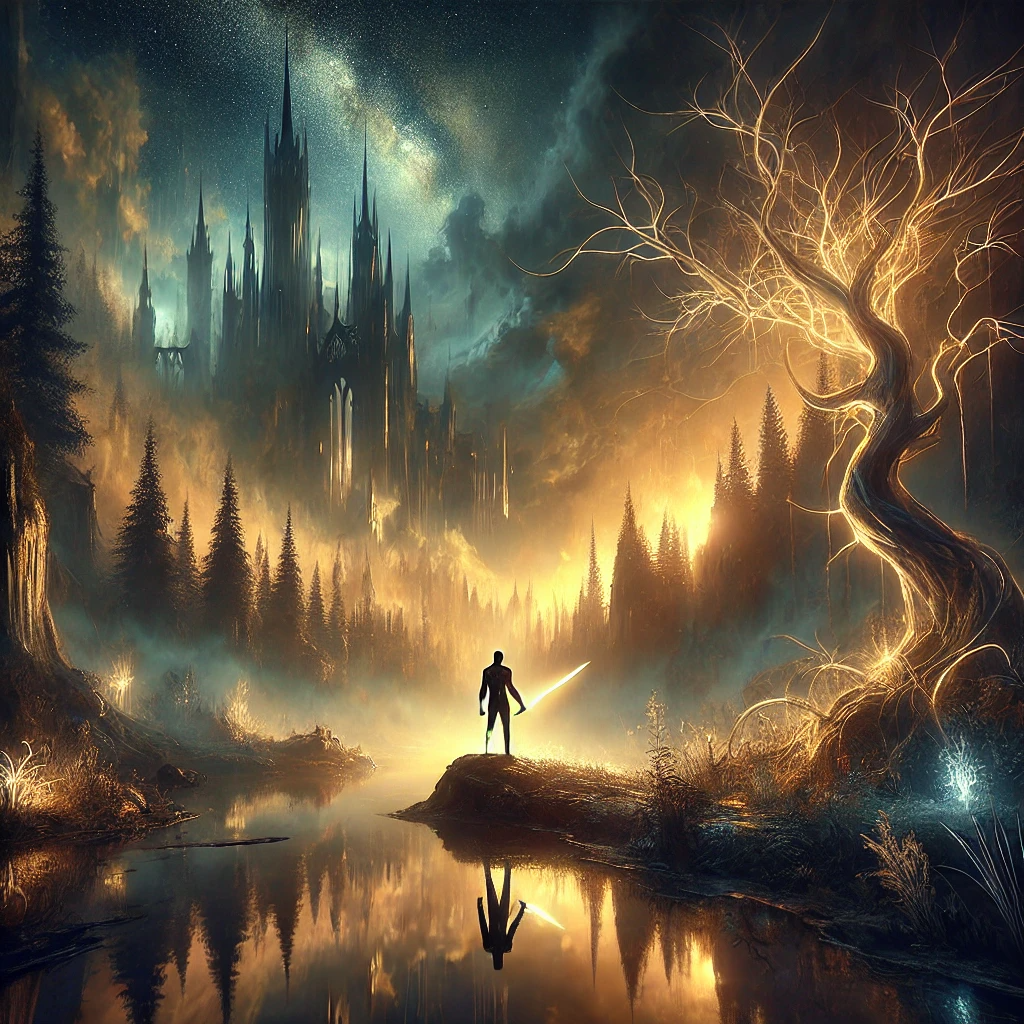The Red Pony, authored by John Steinbeck and first published in 1933, is a poignant collection of four interconnected stories that chronicle the life of Jody Tiflin, a young boy growing up on a ranch in California. Through vivid storytelling, Steinbeck explores themes of maturity, mortality, and the interplay between humans and nature, providing a deeply emotional yet unsentimental glimpse into a boy’s coming-of-age.
Plot Summary
At dawn, the ranch stirred to life, the air crisp with morning chill. Jody Tiflin, a boy of ten, rose from his bed, the harsh clang of the iron triangle summoning him to the day’s chores. Life on the ranch was orderly, disciplined by his father, Carl, whose stern demeanor left little room for indulgence. This was the rhythm of Jody’s life, a series of responsibilities and quiet obediences. Yet, beneath the routine, there was a yearning, a boy’s restless hunger for adventure and understanding.
One morning, Carl and Billy Buck, the ranch hand, led Jody to the barn. There, in the dim light, stood a pony—a red colt with a rough coat and wild eyes. It was Jody’s, his father said, but with conditions. The pony would demand care and discipline, qualities Carl hoped to instill. Jody, awe-struck, reached out tentatively, and in that moment, he felt a spark of pride and responsibility. He named the pony Gabilan, after the mountain range that loomed in the distance, its peaks sharp against the horizon.
Jody devoted himself to the colt, brushing its coat until it gleamed, coaxing trust with soft words and careful hands. Billy, whose expertise with horses was legend in the valley, guided him, teaching the boy how to handle the animal with skill and respect. Jody’s bond with Gabilan deepened, the pony embodying his dreams of independence and mastery over a world that often felt beyond his control.
But the winter winds brought a cruel test. Gabilan fell ill, his vibrant spirit dampened by the relentless rain. Billy Buck promised the boy that the pony would recover, a reassurance Jody clung to even as doubt crept in. The colt’s condition worsened, and despite Billy’s efforts, nature proved unyielding. Gabilan succumbed to pneumonia, leaving Jody shattered, his grief compounded by the betrayal he felt toward Billy’s unfulfilled promise. The sight of vultures circling above the fallen pony seared into his mind, marking his first encounter with the irrevocable finality of death.
The passage of time brought another figure to the ranch—a man from the past, as weathered and quiet as the land itself. Gitano, an elderly wanderer, arrived seeking a place to end his days. Carl, ever pragmatic, dismissed the old man’s request, seeing no value in offering charity to someone who could no longer work. Jody, intrigued by Gitano’s air of mystery, watched him closely, sensing in the man a connection to something ancient and unspoken.
Gitano lingered briefly, sharing cryptic stories of his youth and the far-off places he had traveled. One evening, he vanished, taking with him an old, decrepit horse. Jody imagined Gitano riding into the distant mountains, where the twilight deepened into shadow. It was a departure heavy with symbolism, a quiet statement of dignity in the face of life’s inevitable decline. Though Gitano’s stay was brief, his presence lingered in Jody’s mind, a reminder of life’s transient and solitary nature.
Seasons turned, and Carl struck a bargain with Jody. If the boy cared for the mare Nellie, he would receive her colt as a replacement for Gabilan. Hope rekindled in Jody’s heart as he tended to Nellie with unwavering diligence. When the time came for the colt’s birth, Billy Buck took charge. But complications arose, and the mare’s agony stretched into a brutal reality. Faced with no other choice, Billy sacrificed Nellie to save the colt, delivering it in a scene of blood and desperation. Jody, clutching the trembling newborn, felt the weight of life’s duality—creation born from destruction, joy tempered by sacrifice.
In the wake of the colt’s arrival, the ranch settled into its routines. Then, one afternoon, Grandfather arrived for a visit. Once a leader of pioneers who had journeyed westward, he now lived in the shadow of those glory days, his tales worn thin from repetition. Carl, impatient with the old man’s nostalgia, dismissed his stories as irrelevant, sparking tension around the dinner table. Jody, however, was captivated. He listened intently, drawn to Grandfather’s memories of vast, untamed lands and the sense of purpose they had once carried.
But Grandfather himself seemed weary of the past, acknowledging the emptiness that came after the journey’s end. His tales no longer inspired the vigor they once held, and he lamented that his role had faded into obscurity. In a rare moment of empathy, Jody fetched his grandfather a glass of lemonade, a gesture that spoke of unspoken understanding. It was an act of quiet defiance against his father’s harsh dismissal, but more importantly, it marked a fleeting connection between the boy and the old man, both navigating their own forms of isolation.
As the days passed, Jody returned to his routines, his world shaped by the lessons etched into his heart. The land remained vast and indifferent, its rhythms dictated by nature’s unyielding hand. Yet within its boundaries, Jody began to find a measure of understanding. Loss, responsibility, and fleeting glimpses of connection—these were the elements that formed his initiation into the complexities of life.
The shadows of the mountains stretched long across the ranch as the sun dipped toward the horizon. Jody stood quietly, gazing out at the world that had tested him, shaped him, and left its indelible mark. The winds carried with them the faint echoes of past journeys and future promises, a reminder that life’s paths are never straight but always profound.
Main Characters
Jody Tiflin: A ten-year-old boy, Jody is curious, eager to grow up, and often contemplative. His experiences throughout the stories expose him to life’s harsh realities, shaping his understanding of responsibility and loss.
Carl Tiflin: Jody’s stern and pragmatic father, Carl represents authority and discipline. He enforces strict rules but rarely connects emotionally with Jody.
Billy Buck: A skilled ranch hand, Billy serves as a mentor to Jody. His deep knowledge of horses and practical wisdom make him a comforting presence, though his fallibility is revealed in the stories.
Mrs. Tiflin: Jody’s caring but firm mother, Mrs. Tiflin embodies the nurturing figure of the family, balancing her responsibilities with an underlying warmth.
Grandfather: Carl’s father-in-law, Grandfather is a nostalgic storyteller who represents the fading spirit of westward expansion, contrasting sharply with Carl’s modern practicality.
Gitano: An elderly wanderer who briefly visits the ranch, Gitano is a mysterious figure who symbolizes the inevitable passage of time and the longing for dignity in old age.
Theme
Coming of Age: Jody’s journey from innocence to experience underscores the central theme. Through encounters with birth, death, and disappointment, he learns about responsibility and the complexities of life.
Mortality and Loss: Death looms large in The Red Pony, from the loss of the titular pony to the decline of aging characters like Grandfather and Gitano, reflecting the impermanence of life.
Man’s Relationship with Nature: The ranch setting highlights humanity’s dependence on and struggle against nature. The animals, landscapes, and cycles of life and death are constant reminders of nature’s power.
The Burden of Expectations: The stories examine unfulfilled dreams and the weight of expectations, whether it’s Carl’s pragmatic vision for Jody, Jody’s longing for independence, or Grandfather’s nostalgic ideals.
Isolation and Connection: Each character faces emotional or physical isolation, from Gitano’s lonely departure to Jody’s private struggles, illustrating the difficulty of forming genuine human connections.
Writing Style and Tone
John Steinbeck employs a minimalist yet evocative style in The Red Pony. His prose is straightforward, characterized by vivid descriptions of the natural world and unflinching portrayals of emotional and physical hardship. Steinbeck’s sentences are often lean and purposeful, allowing the weight of his themes to emerge subtly through the narrative rather than overt commentary.
The tone of the stories is both somber and reflective, capturing the stark realities of rural life. Steinbeck maintains a detached perspective, neither sentimentalizing nor romanticizing the events. This objectivity enhances the authenticity of the characters’ experiences, immersing readers in the harsh beauty of the ranch and its unforgiving realities. The restrained narrative invites readers to interpret the deeper meaning behind Jody’s personal growth and the broader life lessons presented.
We hope this summary has sparked your interest and would appreciate you following Celsius 233 on social media:
There’s a treasure trove of other fascinating book summaries waiting for you. Check out our collection of stories that inspire, thrill, and provoke thought, just like this one by checking out the Book Shelf or the Library
Remember, while our summaries capture the essence, they can never replace the full experience of reading the book. If this summary intrigued you, consider diving into the complete story – buy the book and immerse yourself in the author’s original work.
If you want to request a book summary, click here.
When Saurabh is not working/watching football/reading books/traveling, you can reach him via Twitter/X, LinkedIn, or Threads
Restart reading!








